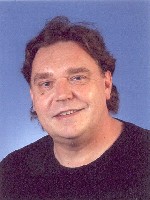Günter von Kiedrowski
CV and key papers
Günter von Kiedrowski (born 27.02.1953 in Werdohl, Northrine-Westphalia) holds the Chair of Bioorganic Chemistry (OC I) at Ruhr University Bochum, Germany. He studied chemistry in Münster and Göttingen (Ph.D. 1983 with L.F. Tietze), was a postdoctoral scholar of Leslie E. Orgel at the Salk-Institute in La Jolla, CA, became Professor for Organic Chemistry in Freiburg (1993-1996) before he moved to Bochum in 1996. The von Kiedrowski group initiated the field of chemical self-replicating systems [Angew. Chem. Int. Ed. 25, 932−935 (1986)], discovered the first case of parabolic growth [Angew. Chem. Int. Ed. 30, 423−426 and 892 (1991)], laid the theoretical foundation for its understanding [Bioorg. Chem. Front. 3, 113−146 (1993)] and introduced early examples for self-replicating molecular networks [Angew. Chem. int. Ed. 32, 1198−1201 (1993), Nature, 369, 221 (1994)]. The group also pioneered the programmable self-assembly of three-dimensionally defined nanoobjects from trisoligos, viz. synthetic three-armed junctons as molecular building blocks [Angew. Chem. Int. Ed. 38, 3311–3315, 1999; Pure Appl. Chem. 2003, 75, 609; Angew. Chem. Int. Ed. 47, 8552-5, 2008] and developed enzyme-free methods for the chemical copying of connectivity in such trisoligos [Nature 420, 286 (2002)] as well as the surface-promoted replication and exponential amplification of DNA analogues [Nature 396, 245 (1998)]. In the context of DNA-nanotechnology the group introducedthermostable, monoconjugable gold-nanoparticles (1.4 nm) based on multidentate thioether ligands [M. Pankau et al. Angew. Chem. Int. Ed. 2006, 118, 1923]. Von Kiedrowski’s SimFit program (1989-2010) [e.g. E. Hayden et al. Angew. Chem. Int. Ed. 2008, 47, 8424, I. Stahl et al. J. Amer. Chem. Soc. 2006, 128, 14014-5, H. Schöneborn et al. Chembiochem 2001, 2, 922-7] is routinely employed for the kinetic modelling and analysis of chemical reaction networks in several labs, including most of the leading labs dealing with chemical self-replication. A current focus is laid on the coupling and integration of autocatalytic reactions based on chemical self-replication, autocatalytic compartimentation, metabolic autocatalysis and organoautocatalysis, chiral symmetry breaking, and informational nanotechnology, which is one of the goals of the emergent field of “systems chemistry”. Another goal of the field is to arrive at a deeper mechanistic understanding of complex systems such as replicators with the penultimate goal to be able to design and “synthesize” or “program” a given dynamic behavior at will [A. Dieckmann et al. J. Syst. Chem. 2010, 1:10] The term “Systems Chemistry” was coined by the group in 2005 [M. Kindermann et al. Angew. Chem. Int. Ed. 2005, 44, 6750]. The field is supported by the



